Literary Analysis Essay
Literary Analysis Essay Outline


Literary Analysis Essay Outline Guide with Examples
Published on: Aug 22, 2020
Last updated on: Oct 26, 2024

People also read
Literary Analysis Essay - Step by Step Guide
300+ Interesting Literary Analysis Essay Topics To Inspire Your Writing
Share this article
Writing a literary analysis essay may seem intimidating at first, but we're here to simplify the process for you. In this guide, we'll walk you through the steps of creating an effective outline that will enhance your writing and analytical abilities.
Whether you're a seasoned student or new to literary analysis, mastering the art of outlining will help you organize your thoughts and express your ideas with clarity and precision.
Let's dive in!
On This Page On This Page -->
The Basics of Literary Analysis Writing
Before diving into the specifics of the outline, let's grasp the fundamental elements of a literary analysis essay .
At its core, this type of essay requires a thoughtful examination and interpretation of a literary work. Whether it's a novel, poem, or play, the aim is to analyze the author's choices and convey your insights to the reader.
The Significance of an Outline
An outline is important for two reasons: It helps you organize your ideas and allows readers to follow along easily.
Think of it as a map for your essay. Without structure, essays can be confusing. By using an outline, you ensure that your writing is clear and logical, keeping both you and your readers on track.
Literary Analysis Essay Format
Let’s take a look at the specific and detailed format and how to write a literary analysis essay outline in simple steps:
Outline Ideas for Literary Analysis Essay
Here are sample templates for each of the outlined ideas for a literary analysis essay:
Five Paragraph Essay
This format is a traditional structure for organizing essays and is often taught in schools. It consists of an introduction, three body paragraphs, and a conclusion. Each body paragraph focuses on one main point or argument.
MLA Formatted Graphic Organizer
This format is designed to help organize your ideas according to the Modern Language Association (MLA) formatting guidelines. It ensures that your essay is properly structured and formatted according to MLA standards.
Compare and Contrast Essay on Two Texts
This format compares and contrasts two texts, highlighting similarities and differences. This is a common method used to analyze literature. There are two common methods: point by point and block method.

Tough Essay Due? Hire Tough Writers!
Literary Analysis Essay Examples Outline
Literary Analysis Essay Outline Middle School
Literary Analysis Outline Graphic Organizer
Critical Analysis Essay Outline Example
Character Analysis Essay Outline
Literary Analysis Essay Topics
Here are some literary analysis essay topics you can take inspiration from:
- Analyze the corrupting influence of power in Shakespeare's "Macbeth."
- Explore the symbolism of the green light in "The Great Gatsby" and its connection to the American Dream.
- Examine Holden Caulfield's journey of self-discovery and identity in "The Catcher in the Rye."
- Understand the use of magical realism in "One Hundred Years of Solitude" and its reflection of Latin American culture.
- Unravel the impact of race, class, and social hierarchy on moral justice in "To Kill a Mockingbird."
- Investigate feminist themes and gender roles in "Jane Eyre": Independence, equality, and the quest for autonomy.
- Examine the theme of fate versus free will in Sophocles' "Oedipus Rex" and its tragic consequences.
- Analyze the allegorical critique of totalitarianism in George Orwell's "Animal Farm."
- Explore survival and resilience in "Life of Pi" through the protagonist's journey of faith and self-discovery.
- Understand existential themes in "The Stranger": Absurdity, alienation, and the search for meaning in an indifferent world.
Need more topic ideas? Check out our ‘ literary analysis essay topics ’ blog and get unique ideas for your next assignment.
In conclusion, crafting a literary analysis essay outline is a critical step in the writing process. By breaking down the essay into manageable sections and organizing your thoughts effectively, you'll create a compelling and insightful analysis that engages your readers.
Remember, practice makes perfect, so don't hesitate to revise and refine your outline until it reflects your ideas cohesively.
In case you are running out of time you can reach out to our essay writing service. At CollegeEssay.org , we provide high-quality college essay writing help for various literary topics. We have an extensive and highly professional team of qualified writers who are available to work on your assignments 24/7.
Get in touch with our customer service representative and let them know all your requirements.
Also, do not forget to try our AI writing tool !
Barbara P (Literature, Marketing)
Barbara is a highly educated and qualified author with a Ph.D. in public health from an Ivy League university. She has spent a significant amount of time working in the medical field, conducting a thorough study on a variety of health issues. Her work has been published in several major publications.
Need Help With Your Essay?
Also get FREE title page, Turnitin report, unlimited revisions, and more!
Keep reading

50% OFF ON CUSTOM ESSAYS
Essay Services
- Argumentative Essay Service
- Descriptive Essay Service
- Persuasive Essay Service
- Narrative Essay Service
- Analytical Essay Service
- Expository Essay Service
- Comparison Essay Service
Writing Help
- Term Paper Writing Help
- Research Writing Help
- Thesis Help
- Dissertation Help
- Report Writing Help
- Speech Writing Help
- Assignment Help
Legal & Policies
- Privacy Policy
- Cookies Policy
- Terms of Use
- Refunds & Cancellations
- Our Writers
- Success Stories
- Our Guarantees
- Affiliate Program
- Referral Program
Disclaimer: All client orders are completed by our team of highly qualified human writers. The essays and papers provided by us are not to be used for submission but rather as learning models only.

Literary Analysis Essay
Literary analysis essay generator.

Literary analysis essays offer a deeper understanding and interpretation of literary works, allowing readers to delve into the intricacies of a story, poem, or novel. Whether you’re a student or a literature enthusiast, analyzing literature can be a rewarding experience. In this article, we will explore a collection of 30+ literary analysis essay examples available in Word, Google Docs, and PDF formats. We will also discuss essential elements such as analysis paper outlines , literary devices, short story analysis, literature reviews, theses, analogies, book reviews, context, and conclusions.
1. Literary Analysis Essay Outline Example
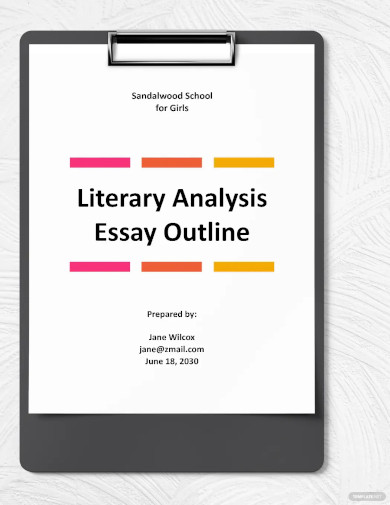
- Google Docs
2. Quotation Literary Analysis Essay Example
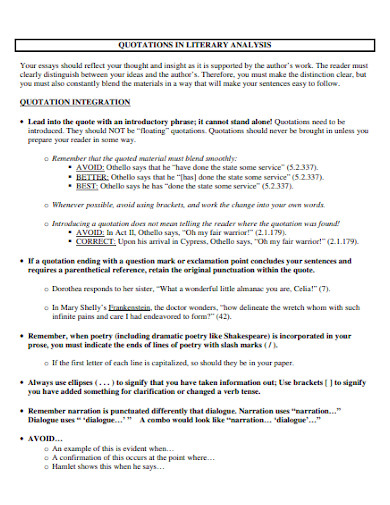
Size: 33 KB
3. Printable Literary Analysis Essay Example
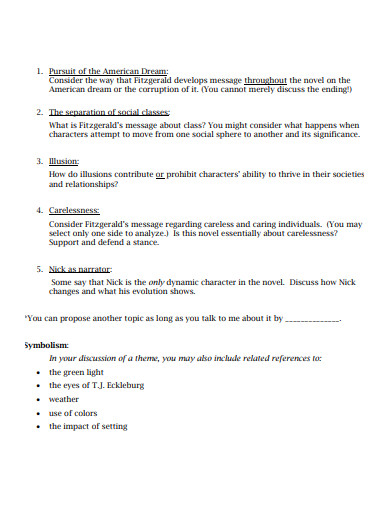
Size: 252 KB
4. Building a Literary Analysis Essay Example
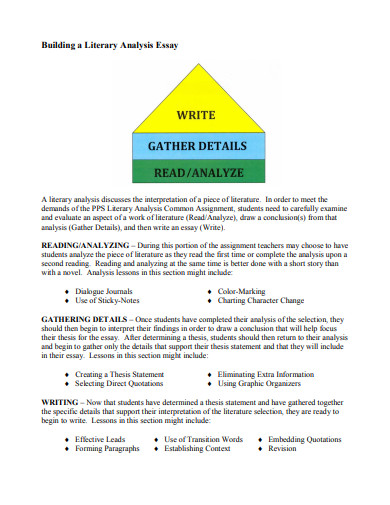
Size: 195 KB
5. Literary Analysis Essay Score Sheet Example
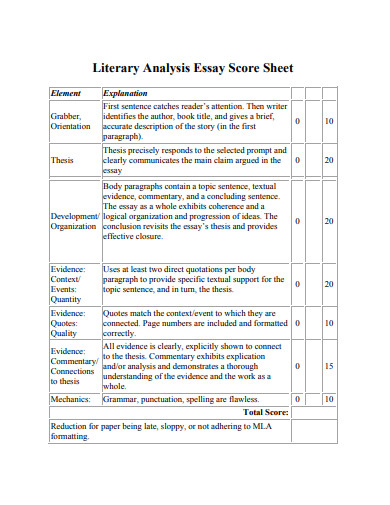
Size: 81 KB
6. Sample Literary Analysis Essay Example
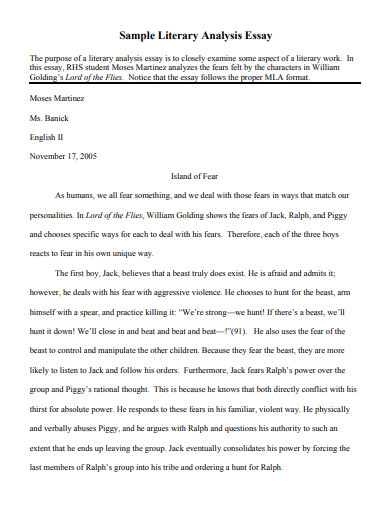
Size: 63 KB
7. Literary Analysis Essay Checklist Example
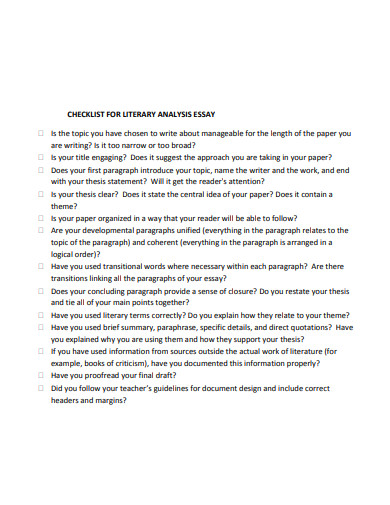
Size: 180 KB
8. Literary Analysis Essay Outline Example
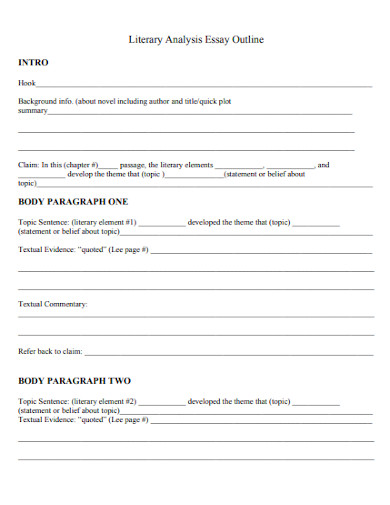
Size: 51 KB
9. Editable Literary Analysis Essay Example
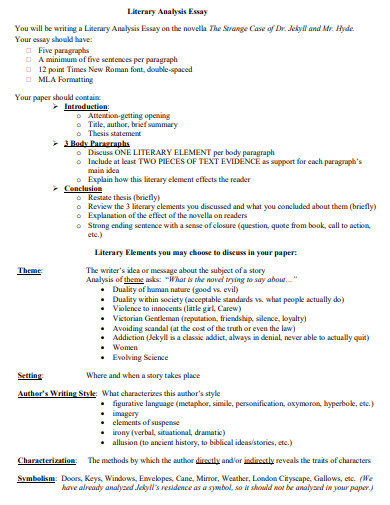
Size: 336 KB
10. Peer Editing Literary Analysis Essay Example
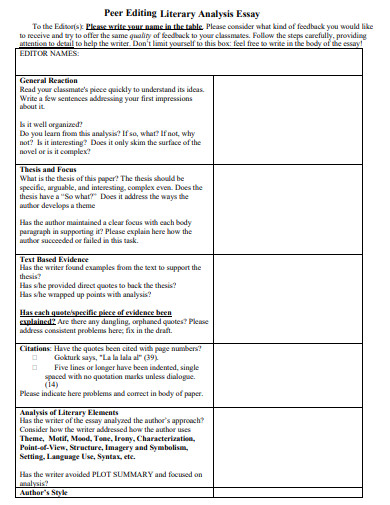
Size: 226 KB
11. Professional Literary Analysis Essay Example
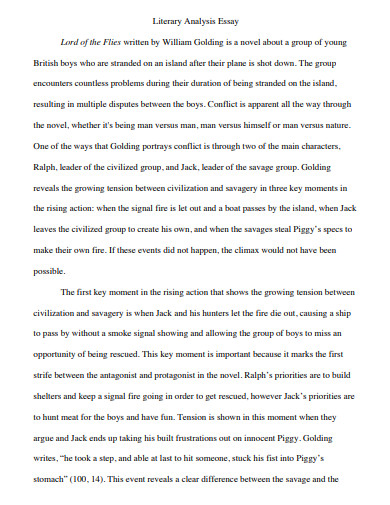
Size: 41 KB
12. Literary Analysis Assessment Outline Essay Example
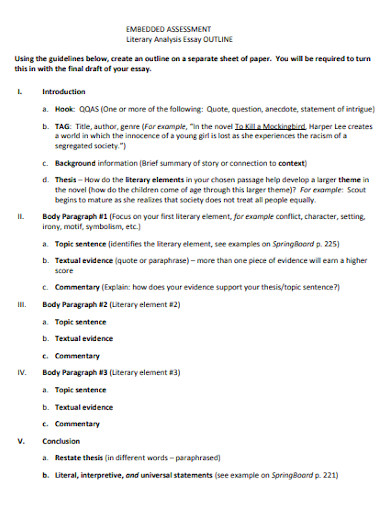
Size: 61 KB
13. High School Literary Analysis Essay Example
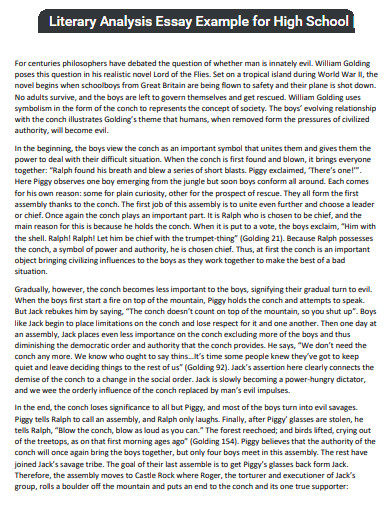
Size: 95 KB
14. Evaluation of a Literary Analysis Essay Example
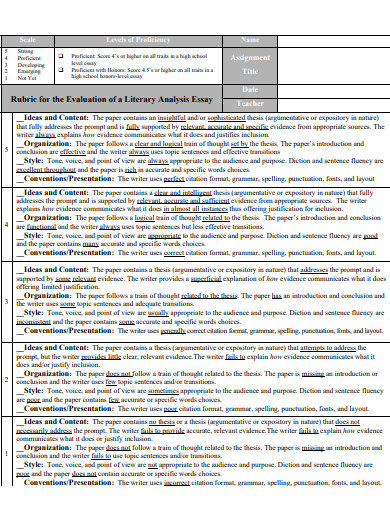
Size: 22 KB
15. Graphic Organizer Literary Analysis Essay Example
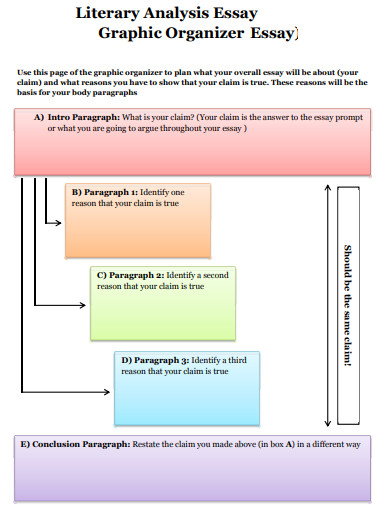
Size: 306 KB
16. Literary Analysis Essay Structure Example
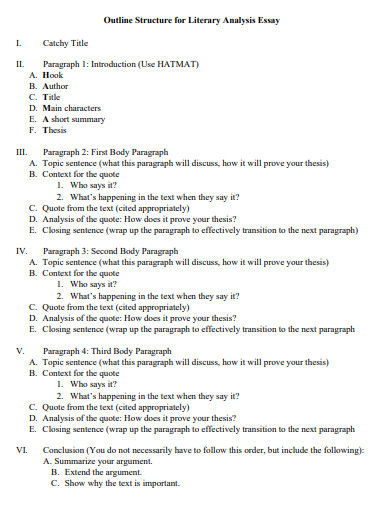
Size: 178 KB
17. Literary Analysis Essay Writing Example
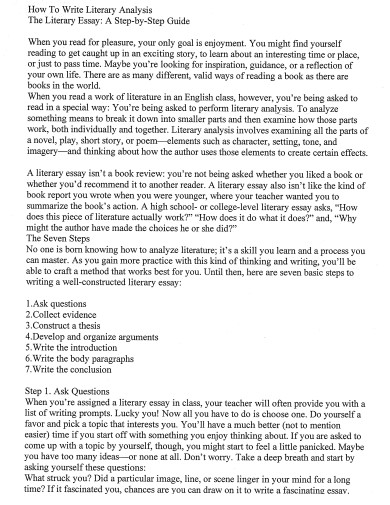
18. College Literary Analysis Essay Example
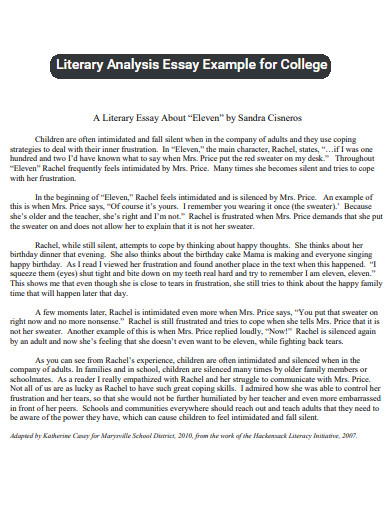
Size: 468 KB
19. Literary Analysis Essay Rubic Example
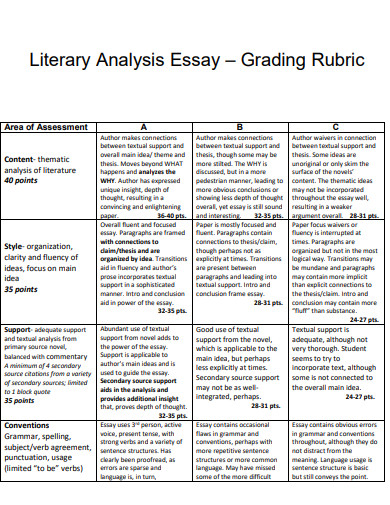
Size: 644 KB
20. Simple Literary Analysis Essay Example
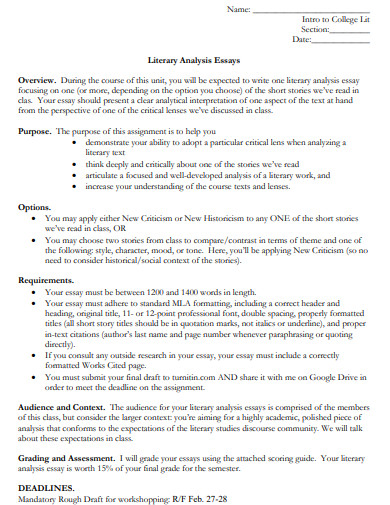
Size: 88 KB

21. Writing a Literary Analysis Essay Example
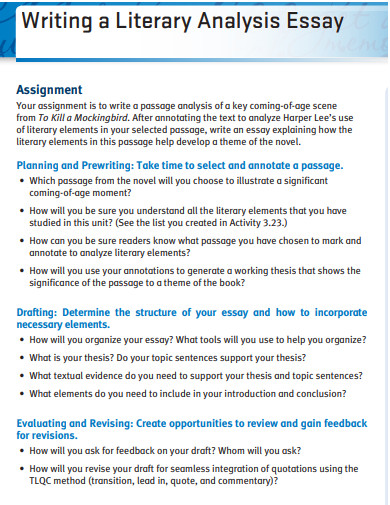
Size: 500 KB
22. Introduction to Literary Analysis Essay Example
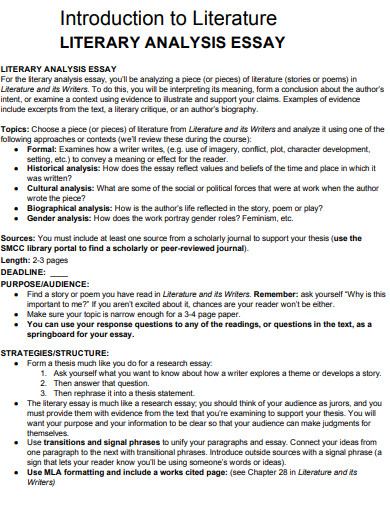
Size: 368 KB
23. Short Story Literary Analysis Essay Example

Size: 103 KB
24. 8th Grade Literary Analysis Essay Example
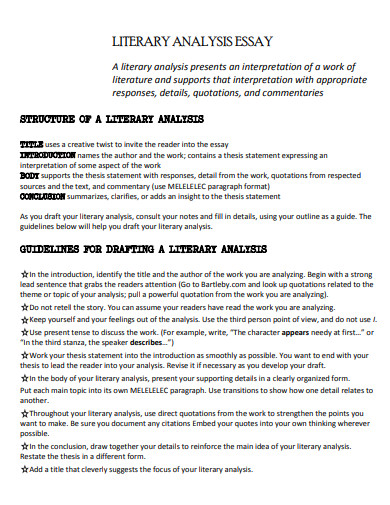
Size: 278 KB
25. Literary Analysis Essay Assignment Example
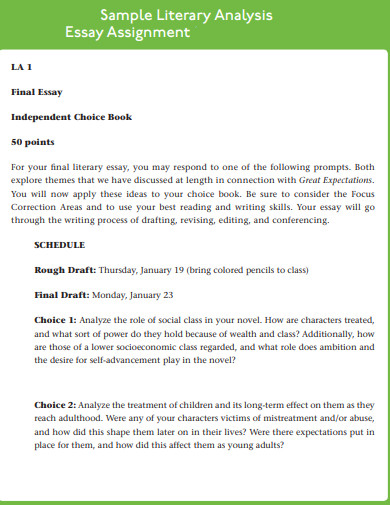
Size: 47 KB
26. Literary Analysis Video Essay Example
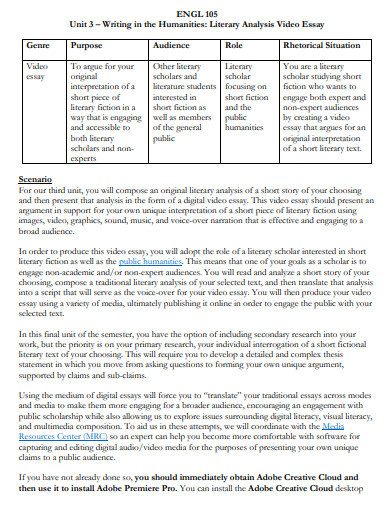
Size: 208 KB
27. Student Guide for Literary Analysis Essay Example
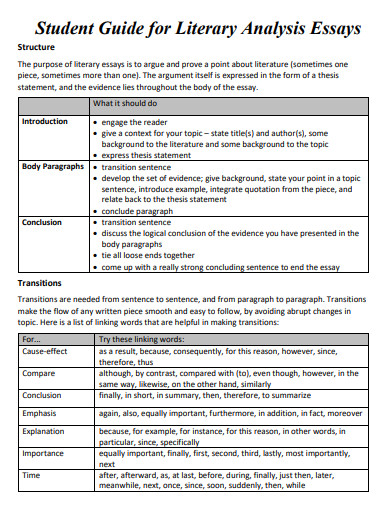
Size: 956 KB
28. MLA Literary Analysis Essay Example
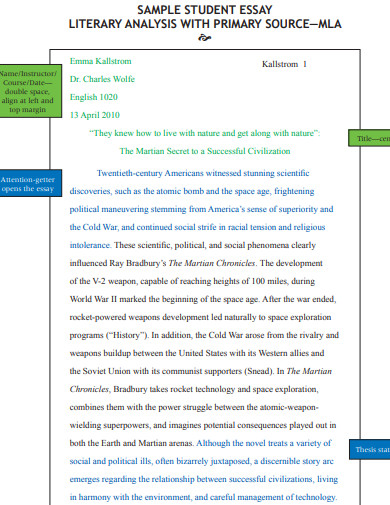
Size: 116 KB
29. Draft Literary Analysis Essay Example
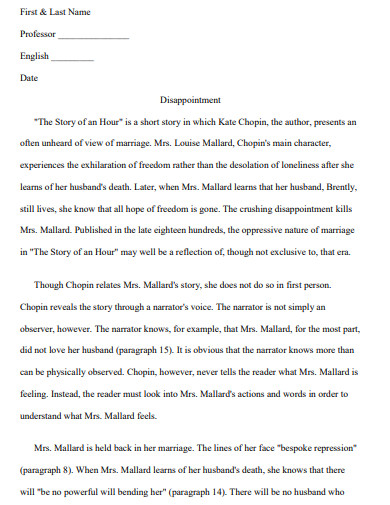
Size: 112 KB
30. 9th Grade Literary Analysis Essay Example
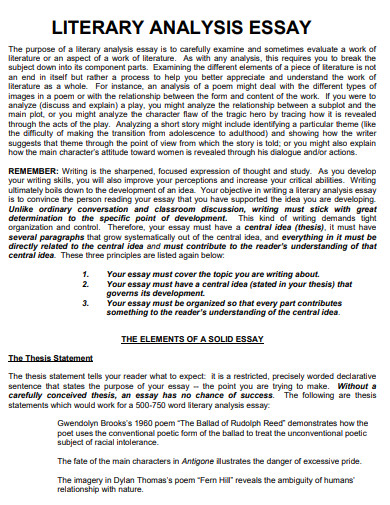
Size: 93 KB
31. Literary Analysis Essay Guide Example

Size: 36 KB
What is a Literary Analysis Essay?
A literary analysis essay is a critical examination and interpretation of a literary work. It involves analyzing various elements such as plot, characters, themes, and literary devices to uncover deeper meanings and insights. By dissecting the text and exploring its nuances, readers can gain a deeper appreciation for the author’s intentions and the work’s impact. A well-written literary analysis essay provides a comprehensive analysis that goes beyond surface-level observations.
How to Write a Literary Analysis Essay
Before we dive into the examples, let’s outline the steps involved in writing a literary analysis essay:
Step 1: Choose a literary work:
Select a literary work that you want to analyze. It could be a novel, short story, poem, or play. Ensure that the chosen work is rich in literary elements and offers ample material for analysis.
Step 2: Familiarize yourself with the work:
Read the literary work carefully, taking note of important plot points, characters, themes, and literary devices. Pay attention to the author’s writing style and the overall tone of the work.
Step 3: Develop a thesis statement:
Craft a strong thesis statement that encapsulates your main argument or interpretation of the literary work. Your thesis should be clear, concise, and debatable, providing a roadmap for your analysis.
Step 4: Gather evidence:
Collect evidence from the literary work to support your thesis statement. Look for specific examples, quotes, and literary devices that reinforce your analysis. Take note of the context in which these elements appear.
Step 5: Organize your essay:
Create an analysis paper outline to structure your essay effectively. Divide your essay into introduction, body paragraphs, and conclusion . Each body paragraph should focus on a specific aspect of your analysis, supported by evidence.
Step 6: Write your essay:
Start with an engaging introduction that provides background information and introduces your thesis statement. In the body paragraphs, analyze different aspects of the literary work, providing evidence and explanations. Ensure a smooth flow between paragraphs. Conclude your essay by summarizing your main points and reinforcing your thesis .
What are some examples of literary devices?
Literary devices are techniques used by authors to enhance their writing and convey meaning. Examples include metaphors, similes, personification, alliteration, and symbolism. For a comprehensive list and explanations, refer to Literary Devices .
Are there any specific examples of short story analysis essays?
You can find examples of short story analysis essays in PDF format here . These examples provide insights into analyzing the elements of a short story effectively.
How does context impact literary analysis?
Context plays a crucial role in literary analysis as it helps readers understand the historical, social, and cultural background in which the literary work was written. It provides insights into the author’s intentions and influences the interpretation of the text.
Text prompt
- Instructive
- Professional
Analyze the theme of courage in a novel for your Literary Analysis Essay.
Write about the use of symbolism in a short story for your Literary Analysis Essay.

How to Write a Literary Analysis Paper Outline with Examples
Analyzing literature means looking closely at a written piece, figuring out what it means, and understanding why the author made certain choices. This applies to things like stories, novels, plays, and poems.
When you write a literary analysis essay, it’s not about just summarizing the story or giving your opinion. Instead, it’s like making an argument about how the author uses language, perspective, and structure to create effects and convey ideas.
Finding ideas for a literary analysis essay means knowing about the background, main ideas, and symbols in the work. Before you start writing, read the text carefully and come up with a main idea (thesis statement) to guide your essay. Following these tips, both new and experienced writers can write a thoughtful essay that gives smart explanations about a piece of literature.
What You'll Learn
Guidelines to Writing an Outstanding Literary Analysis Paper
Step 1: Carefully Read the text and look out for the literary devices
The first thing you should do is read the text carefully and take some notes. While you’re reading, pay attention to the parts that interest you the most, surprise you, or confuse you. These are the things you’ll explore in your analysis.
When you’re analyzing literature, your goal is not just to explain what happens in the story, but to understand how the writing itself works on a deeper level. Look for special techniques that writers use to give meaning and create effects—these are called literary devices. If you’re comparing different texts, also try to find connections between them.
To start your analysis, focus on a few important areas. Think about how each part of the text relates to the others. You can use highlights or notes to remember important parts and quotes.
Look out for the language that has been used
Think about how the writer talks. Are the sentences short and clear, or are they fancy and complicated? Look for special or weird words. Do they use words in a way that means something different than what it usually means? Like saying “her eyes were oceans” when they mean her eyes were really deep and mysterious. Watch out for pictures in the writing—pictures that show up a lot and mean something important. And don’t forget, in stories and poems, words can mean more than just what they say directly
Consider the narrators voice
Think about:
- Who is telling the story?
- How are they telling it?
- Is it someone personally involved (using “I”) or someone observing from afar (using “he” or “she”)?
Also, think about the narrator’s viewpoint. Do they know everything about everyone , or do they only know some things? Can we trust them, or are they possibly lying or mistaken?
Consider the tone of the text. Is it meant to be funny, sad, or something else? Are serious things treated as jokes, or the other way around? Is the story more real-world or more fantastical?
Consider the structure of the text
Think about how stories are organized. Novels have chapters and parts, poems have lines and stanzas, and plays have scenes and acts. Consider why authors choose to divide their works this way.
Also, think about the less formal ways stories are put together. Does the plot follow a timeline, or does it go back and forth in time? Does it start in the middle of the action? Is there a clear high point in the story?
For poems, think about how the rhyme and rhythm affect your understanding and the tone. Reading it out loud can help you feel this.
In plays, notice how relationships between characters develop in different scenes, and how the setting connects to the story. Keep an eye out for dramatic irony, where the audience knows something the characters don’t, adding extra meaning to what they say or do.
Literary Analysis Paper Outline
I. introduction.
Set up the context of the novel. This includes stating the author, the title of the work, and perhaps some details as to the period the piece was written in or anything else you think would be relevant for your reader to know before reading your analysis. This is where you might also include a very short summary of the text you are analyzing (by short, Imean no more than a sentence or two).
Claim:
Your claim will be your stance as to the meaning (or a meaning) behind the novel (or aspects of the novel). Example: While survival is still a major topic throughout the story, “The Open Boat” can also be read as a striving for community, . . .
- Reasons/key areas/focus:
These will be your reasons that you have that support your claim. Here is where you might delve into the use of literary devices in the text. Example : . . . . as the survivors find a sort of friendship with one another, and as they struggle together to live.
II. Reason #1
- Topic Sentence:
This sentence will state the first reason that you have supporting your claim in your thesis. Phrase this sentence in a way that restates the reason you had in your thesis, and explain how it is relevant to your claim.
Example: Multiple points throughout the story highlight the moments of the passengers finding a type of friendship with each other.
- Introduce the Evidence:
Either briefly state the context of the quote you are about to give, or give a littleglimpse into the function of the quote within the story.
Example: The narrator of the text specifically highlights the brotherhood that thesurvivors have formed:
- Quote:
Give the quote, along with the citation.
Example: “It would be difficult to describe the subtle brotherhood of men that was here established on the seas. No one said that it was so. No one mentioned it. But it dwelt in the boat, and each man felt it warm him” (Crane 370).
- Explication (un-packing the quote):
Explicating the quote involves picking out the specific words and language usedby the author within the quote. Essentially, you are saying what the quote means.
Example: This brotherhood is described as “subtle,” and the text goes on to explain that no one has verbally discussed this reality, which hints that it may not even consciously recognized by each of the men. However, even though it is not fully recognize, it is tangibly felt by each of the men, as each “felt it warm him.”
- Analysis (consider the larger significance of your explication):
After detailing what the quote means, you need to take another step outwards. What does this use of language mean? Why is this quote important? What conclusions can we draw from this evidence?
Example: As the narrator himself is commenting on the apparent brotherhood between the survivors, the conclusion is that this is no mere illusion of a single passenger . . .
- Tie-Back to Thesis:
How does this evidence support your thesis? Be sure to give a tie-back that shows how this example that you’ve analyzed proves your thesis. Example: . . . but rather a reality of the community that is drawing the four men together.
Are You Working on a Research Paper?
Feel free to let our professional writers help you
III. Section II – Reason #2
(Note: You can have as many sections as you like; two is probably a good minimum, and the maximum would depend on the paper length requirements set by your instructor. Also, if you have more than one quote/piece of evidence, you can have more than one paragraph per reason.)
A. Topic Sentence B. Evidence C. Quote D. Explication E. Analysis F. Tie-Back to Thesis IV. Conclusion
Restate Thesis:
Restate your thesis again in the conclusion. Be sure to change the wording so it is not repetitive, and so that it is more conducive to a conclusion, rather than an introduction. Example: Apart from the obviously seen theme of survival in the face of an in a different world, the striving of the four survivors for community in Crane’s “The Open Boat” is decidedly a major theme.
- Larger Significance of Thesis:
Take a step further outwards from your initial claim. What is the larger significance of what you’ve just argued, beyond the contents of the story? Example: While this particular story of Crane’s is usually categorized as a Naturalist piece, the search for community demonstrates a very Modernistic theme.
- Wrap-up Statement/Call for Further Inquiry:
Either provide a satisfying concluding statement to end your paper, or perhaps spark more interest in your reader by leaving them with a thought that they can pursue further. Example: Perhaps rather than lumping this piece in with Naturalism, it would be better placed as a bleed from Naturalism to Modernism.
Sample Literary Analysis Essay college
This novel is about a lady”: brett ashley in the sun also rises.
While Ernest Hemingway’s The Sun Also Rises is told from the viewpoint of one Jake Barnes, another prominent figure within the novel is Lady Brett Ashley. In fact, in Hemingway’s original opening for the novel, he had written, “This novel is about a lady. Her name is Lady Ashley” (Qtd. in Martin 70).
Brett, as she is developed in the novel, has been painted in different lights, depending on the interpreter, ranging from a sympathetic view to one of condemnation. The portrait of her that I will attempt to show is one of a human being, caught between the ideologies of two eras.
Brett Ashley is a woman living during an age of a new femininity and sexual freedom, during the end of the repressive Victorian era. Reflecting changing behaviors, she wears pants and has her hair cropped, and she is sexually uninhibited.
Her experience may be analogous to the stereotypical college freshman who grew up in a strict household, one where the idea of drinking before twentyone is demonized, so the freshman was not educated in safe practice.
The newfound freedom is exhilarating, and the freshman is known to binge-drink, not thinking of his or her tolerance level and the consequences, such as an incapacitating hangover. The sexual promiscuity of Brett, and other women of her time period, may be viewed in the same light: after a repressive era, sex is, in a way, “new” and exciting.
However, because of the prior taboo of discussing sex, a sense of responsibility, self-respect, and self-care was likely not passed down to Brett. Because of this, she, as a “new woman,” binges on sex. This is not necessarily because she is an emasculating man-eater.
Rather, this is a reflection on her being almost child-like in her behavior, being given power without being made aware of the responsibility of it. As Martin expresses, for Brett, the need to rebel against the traditional idea of the feminine outweighs the practice of responsible sex (67-8, 71).
However, her existence during such a cultural transition takes a toll on Brett’s psychological well-being. In trying to cope with Robert Cohn’s infatuation with her, for example, she turns to alcohol: As Jake returns a bottle of Fundador to the bartender, she stops him. “‘Let’s have one more drink of that,’ Brett said. ‘My nerves are rotten’” (Hemingway 186).
As stated by Martin, “In spite of the fact that Brett tries to break free of patriarchal control, she often vacillates between the extremes of self-abnegation and self-indulgence, and her relationships… are filled with ambivalence, anxiety, and frequently alienation” (69).
Among one of her many discussions with Jake where she admits her dissatisfaction and misery, Brett confides in him that “When I think of all the hell I put chaps through. I’m paying for it all now” (34). Thus, Brett is not without a sense of guilt.
Despite this, she continues with one affair after another, knowing how it has affected the men she has been and will be with. There must then be other driving factors in her behavior beyond a desire for sexual pleasure.
Like many people of her generation, in testing out a life free of restrictive and seemingly worn-out Victorian ideologies, Brett feels disillusionment and a loss of agency after World War I, leaving her with a “moral and emotional vacuum” (Spilka 36).
She cannot even take solace in religion. When she attempts to pray for her young lover Romero before his bullfight, she becomes uncomfortable in the atmosphere of the chapel: “‘Come on,’ she whispered throatily. ‘Let’s get out of here. Makes me damned nervous’” (Hemingway 212).
She attempts to fill this void using intimate encounters with men, seeking a momentary feeling of human connection but remains unwilling to submit herself to anyone long term. This is particularly seen in her relationship with Jake, as she constantly uses him as a financial source and emotional support, all the while knowing that he is tormented by all her lovers (Spilka 42-3). Onderdonk points out that, at times, Brett appears to want a true relationship, such as with Romero, before he attempts to “tame” her (81).
Yet, as Djos notes, she generally manipulates men, asserts her dominance over them, and avoids commitment to them (143, 148). This behavior might be interpreted as a sign that the sexual freedom Brett is trying out inevitably leads to an ethical dead end.
Unlike an imperialistic government, however, Brett is a human being with a conscience, giving rise to the aforementioned guilt. This guilt, coupled with the internal void common to the Lost Generation, is what drives her and her colleagues to seek comfort in a bottle.
Often taken for a sign of immorality, alcoholism here signifies quite the opposite. It is Brett’s conscience and her discomfort with the lack of moral direction that drive her to drink. Djos presents the following theory, based on real-life alcoholics: “There is a great deal of fear here, fear of selfunderstanding, fear of emotional and physical inadequacy, and … fear of each other” (141-2).
Because Brett and her friends are travelling an unmapped road, with no signs pointing to ethical landmarks or spiritual meaning, they must deal with the uncertainty of their situation. The characters throughout the novel do seem to have shallow interactions and relationships with each other, yet the fact that so much is left unsaid between them is evidence of Hemingway’s “tip of the iceberg” style.
For them alcohol is a social lubricant, and even a means to survive day by day, minute by minute, suggesting that these characters are navigating great psychological challenges (Djos 141) and must suffer in isolation as they do so. Brett is no exception to this experience. Early on in the novel, Brett alludes to this despair when she bemoans to Jake, “Oh, darling, I’ve been so miserable” (Hemingway 32).
Brett is far from being a role model or the picture of perfection. Yet, she is not a cold-hearted succubus, either. She is a woman attempting to find her place in the wake of a war and a gender revolution, surrounded by changing ideas, gender roles, and cultural standards.
Hiding behind a wall of alcohol abuse, she struggles, as did many women of her time, between her libido and desire for freedom from patriarchy and male ownership, and her sense of guilt and discomfort with herself and others. Brett is nothing more, or less, than a human being experiencing the tumultuous waves produced by life.
Works Cited
- Djos, Matts. “Alcoholism in Ernest Hemingway’s The Sun Also Rises: A Wine and
- Roses Perspective on the Lost Generation.” 1995. Ernest Hemingway’s The Sun Also Rises, edited by Linda Wagner-Martin, Oxford UP, 2002, pp. 139-53.
- Hemingway, Ernest. The Sun Also Rises. Scribner, 1926.
- Martin, Wendy. “Brett Ashley as New Woman in The Sun Also Rises.” New
- Essays on The Sun Also Rises, edited by Linda Wagner-Martin, Cambridge UP, 1987, pp. 65-81.
- Onderdonk, Todd. “‘B itched’: Feminization, Identity, and the Hemingwayesque
- in The Sun Also Rises.” Twentieth Century Literature, vol. 52, no 1, 1 Mar. 2006, pp. 61-91. Academic Search Complete. doi:10.1215/0041462X-2006-2007. Accessed 16 Sept. 2013.
- Spilka, Mark. “The Death of Love in The Sun Also Rises.” 1958. Ernest
- Hemingway’s The Sun Also Rises, edited by Linda Wagner-Martin, Oxford UP, 2002, pp. 33-45.
Does the Sun Rise? A Study of Metaphors in Ernest – literary analysis example for a short story
Although Hemingway’s novel The Sun Also Rises begins with an epigraph from the biblical book of Ecclesiastes that suggests the constantly renewing cycles of the earth and of human generations, the author’s use of metaphors in this story raises the question of whether we will always be able to recover from our own destructive behavior.
If it is true that humans and the earth are resilient and that no force can disrupt the cycle of rebirth and regeneration, the novel should leave readers feeling optimistic. However, it does not end on a positive note. Instead, it ends with confirmation that even though Brett Ashley likes to imagine a happy life with protagonist Jake Barnes, they are too damaged to have one.
Jake’s cynical response to Brett’s fantasy reminds us of this point: “Isn’t it pretty to think so?” Jake’s difficulty coping with his injury, his tendency to self-medicate with alcohol, his inability to pray, and his failure to sustain an intimate relationship with another person all exemplify the irreversible destruction inflicted byWorld War I. Specifically through the metaphors of Jake’s wound and the tainted Pamplona fiesta, the novel conveys the possibility that if we are not careful, we can dangerously disrupt the cycle of renewal.
Jake’s service as an American soldier in World War I has left him with an unusual wound: he took a hit to the groin and his sexual organs were damaged. Not only does this wound affect him physically, preventing him from being able to have sex and to reproduce, but it also affects him psychologically, robbing him of masculine confidence and of the chance for an intimate relationship with the woman he loves, Brett Ashley.
Jake’s response to the injury as he looks in the mirror reveals how powerfully the scar affects him: “I looked at myself in the mirror of the big armoire beside the bed….Of all the ways to be wounded. I suppose it was funny” (38). Although Jake tries to laugh off the injury, he suffers from the constant effort to cope with it and the general effects of his war experience: “I lay awake thinking and my mind jumping around.
Then I couldn’t keep away from it, and I started to think about Brett and all the rest of it went away. I was thinking about Brett and my mind stopped jumping around and started to go in sort of smooth waves. Then all of a sudden I started to cry” (39). The wound is a constant reminder to Jake that his life is different now.
Yet it also serves as a general metaphor for the psychological wounds he and all his friends are coping with. Like Jake’s genital scar, his friends’ pain is kept well-covered. They almost never speak of the war. When Robert Cohn asks Mike Campbell if he was in the war, Mike answers, “Was I not?” And then the subject shifts to a funny story about Mike’s stealing medals earned by someone else so Mike could wear them to a formal dinner.
Although he seems fun-loving, ready to laugh and party with his companions, Mike drinks and spends money indiscriminately in order to cope with his pain. We see the characters’ dysfunctional behavior throughout the novel as the group constantly drinks and engages in distractions to cope with their own psychological wounds. The worst effects of these injuries are their inability to find hope in anything, even God, and to enjoy close and healthy
Relationships with each other.
Another metaphor employed effectively in the novel to suggest irreversible destruction is the ruined bull fights. Jake has been an aficionado of the bull fights for many years. He considers them almost sacred. He shares this feeling with his friend Montoya, at whose hotel he stays when he comes to Pamplona for the fiesta.
“I had stopped at the Montoya for several years. We never talked for very long at a time. It was simply the pleasure of discovering what we each felt.” (137). Even though Jake’s mind wanders when he goes to church now, he has been able to maintain this special experience of the bull fights. The way he describes this “art” reveals that he sees something pure in it—a chance to confront one’s fears with dignity, courage, and grace and then destroy those fears: “Romero’s bull-fighting gave real emotion, because he kept the absolute purity of line in his movements and always quietly and calmly let the horns pass him close each time” (171). Since the events recur each year during fiesta, there is a sense of renewal associated with it.
However, when Brett initiates Romero into manhood through a brief sexual affair, it not only compromises Romero’s innocence and purity as an artist, but it spoils the experience of fiesta for Jake. Montoya, his fellow aficionado blames Jake and his friends for not respecting Romero and the bull fight, and the loss of this friendship hurts Jake. Just before the group leaves town, Jake says, “We had lunch and paid the bill. Montoya did not come near us” (232).
Montoya’s previous regard for Jake will not likely be regained, since the aficion, or passion, they shared was very rare, and the affair has spoiled their bond. Like Jake and his friends’ faith in anything transcending ordinary mundane life, Jake’s experience of the bull fight has been tainted now by the dysfunctional actions of him and the rest of the group. This metaphor suggests that some kinds of destruction are permanent.
As the novel concludes, the reader wants to believe that Jake will survive and find some kind of happiness. Yet, the metaphors of Jake’s wound and the tainted bull fights suggest that some kinds of damage cannot be undone. The novel implies that, as a result of one of the most destructive wars in human history, these characters will simply have to learn to live with their injuries and cope with their lost hopes. Their hardship serves as a warning that humans should think carefully before waging war against each other.
Works Cited Hemingway, Ernest. The Sun Also Rises . Scribner, 1926.
here’s how to cite a poem
Related Articles
Literary Analysis Essay Outline – A Step By Step Guide
How to Write a Literary Analysis Essay | A Step-by-Step Guide
Start by filling this short order form order.studyinghq.com
And then follow the progressive flow.
Having an issue, chat with us here
Cathy, CS.
New Concept ? Let a subject expert write your paper for You
Post navigation
Previous post.

📕 Studying HQ
Typically replies within minutes
Hey! 👋 Need help with an assignment?
🟢 Online | Privacy policy
WhatsApp us

IMAGES
COMMENTS
c. Introductions should identify the work of literature being discussed, name the author, and briefly present the issue that the body of your essay will more fully develop (your thesis).
c. Introductions should identify the work of literature being discussed, name the author, and briefly present the issue that the body of your essay will more fully develop (your thesis).
A literary analysis essay delves into the examination and interpretation of a literary work, exploring themes, characters, and literary devices. Below is a guide outlining the format for a structured and effective literary analysis essay.
Aug 22, 2020 · Struggling with your literary analysis essay outline? Learn how to structure your literary analysis essay in our step by step guide. Download free PDF template!
When writing an essay analyzing literary work, you will need to stick to a particular structure that shows the development of your thesis—from thesis statement, main points, supporting evidence, analysis to conclusion. To make sure you do not miss any of these components, you should use a template.
Jul 23, 2024 · Explore a collection of 30+ literary analysis essay examples in Word, Google Docs, and PDF formats. Learn how to analyze literature effectively, understand literary devices, create a strong thesis, and provide a comprehensive conclusion.
There are various different ways to structure an essay, and using an essay outline template allows you to decide on the best structure for your essay. Whether you want a balanced argument, or if you’re trying to persuade someone of your idea, then there will be an essay outline that works for you.
1. Your essay must cover the topic you are writing about. 2. Your essay must have a central idea (stated in your thesis) that governs its development. 3. Your essay must be organized so that every part contributes something to the reader’s understanding of the central idea. THE ELEMENTS OF A SOLID ESSAY The Thesis Statement
Begin each paragraph with a topic sentence that states an idea related to the thesis. Organize your essay around ideas relating to your critical lens. In the body of your essay, incorporate information from your primary and secondary sources (novel and critical theory information. Cite these sources parenthetically, using MLA format.
Outline Structure for Literary Analysis Essay I. Catchy Title II. Paragraph 1: Introduction (Use HATMAT) A. Hook B. Author C. Title D. Main characters E. A short summary F. Thesis III. Paragraph 2: First Body Paragraph A. Topic sentence (what this paragraph will discuss, how it will prove your thesis) B. Context for the quote 1. Who says it? 2.
Dec 16, 2023 · Finding ideas for a literary analysis essay means knowing about the background, main ideas, and symbols in the work. Before you start writing, read the text carefully and come up with a main idea (thesis statement) to guide your essay.